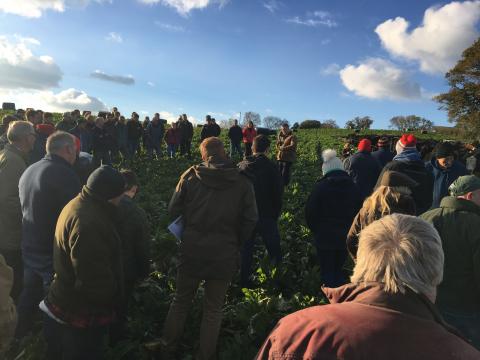7 November 2018
A Welsh beef producer is maximising output per hectare (ha) by grazing cattle on fodder beet.
Marc Jones, who farms 500 acres at Trefnant Hall on the Powis Estate with his parents, David and Jane, is driving output on a forage-based system; fodder beet, which has the potential to achieve more than 20 tonnes of dry matter (DM)/ha, is central to this.
“With Brexit on the horizon and changes in the subsidy system going forward it, is vital that farms like this push forward to stay profitable,’’ Mr Jones told a large turnout of farmers at a Farming Connect open day at Trefnant Hall.
Beef cattle graze fodder beet from the end of October, achieving average daily liveweight gains of 1kg/animal. In an average year, a net profit of £300/animal is achieved but this summer’s exceptionally dry conditions has reduced this by £100/animal.
The variety, Geronimo, is grown; this is a medium dry matter type-beet which grows around 55%-60% above ground.
Mr Jones says the crops costs £1,126/ha to grow and around 20ha is grown each year.
“We keep 300 yearling cattle on it for five months and 600 sheep for two months,’’ he says. “The sheep go on it in the last week of December and come off it in late February. As there isn’t much protein in the beet, the ewes need three to four weeks off the crop before lambing. During this period, they are on grass and get adequate energy and protein from that.’’
Three rows of silage bales are placed in the field and the crop is then strip grazed from the top of the field down the slope; cattle have three bales a day.
“It works out that they have 3kg of dry matter of silage per day and around 9 kg of dry matter of fodder beet,’’ says Mr Jones.
Fodder beet was the focus of the Farming Connect open day, with New Zealand-based Jim Gibbs, a global expert in the use of the crop in livestock and dairy systems, leading the discussion.
Dr Gibbs, of Lincoln University, described fodder beet as a “really profitable crop’’. “From a dry matter perspective it is the cheapest crop you can grow,’’ he insisted. “It costs three or four times more to produce silage than beet.’’
He believed there had been a reluctance by Welsh farmers to graze fodder beet in situ because of perceived issues with rumen acidosis.
“Historically, it was thought that it was toxic for cattle when grazed and that you could only feed a small amount but, if you gradually introduce animals to it and provide adequate fibre, it is one of the best crops you can feed,’’ Dr Gibbs suggested.
He advises a step transition for beef cattle, feeding 1kg DM/head/day on day one and increasing by 1kg every second day until day 14. Cattle can then have access to fodder beet ad-lib.
For sheep, no transition period is needed and neither is a supplementary feed, said Dr Gibbs. The crop is suitable for ewes but he doesn’t recommend it for finishing lambs. “It doesn’t have a high enough protein content for this purpose,’’ he explained.
To achieve performance and liveweight gain, high intakes are needed; these can be achieved if the transition, design of the paddocks and crop management are correct.
As part of his work on fodder beet, Dr Gibbs has explored many myths and misconceptions surrounding the crop.
The first of these is that fodder beet contains anti-nutritional compounds, such as oxalates and nitrates, which supposedly meant the crop could only be used at low levels.
This, he said, is wrong. “There are no anti-nutritionals that are of any consequence.”
Maximising intakes in beef cattle, he advised, required a shift in thinking in the amount of feed left behind in the field, based on three day allocations.
“The amount left behind is more than most farmers are comfortable with -25% on the first day, 5% on the second and none of the third day,’’ said Dr Gibbs.
He said the crop became four times more expensive if lifted - grazing reduces harvesting and storage costs and simplifies feeding.
The event was organised by Lisa Roberts, Farming Connect Red Meat Technical Officer for Mid Wales.
Making the most of every hectare and maximising dry matter production is vital for driving farm profitability, she said.
“This event provided farmers with knowledge and confidence to grow and utilise fodder beet to maximise output.’’
Table 1 crop costs/ha at Trefnant Hall
|
Item |
Cost/ha (£s) |
|
Seed |
188 |
|
Lime |
75 |
|
Fertiliser |
198 |
|
Spray |
160 |
|
Contracting |
255 |
|
Rent |
250 |
|
TOTAL |
£1,126 |
Table 2 DM yield and cost per kg of DM at Trefnant Hall
|
Dry Matter Yield |
Pence per kg/dm |
|
30t/DM |
3.75 |
|
25t/DM |
4.50 |
|
20t/DM |
5.63 |
|
15t/DM |
7.51 |

